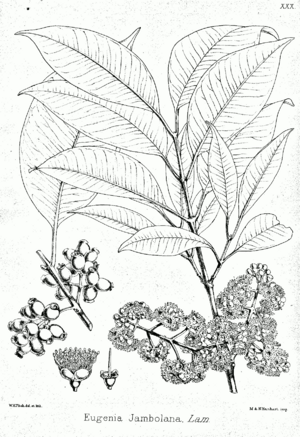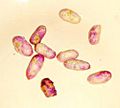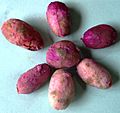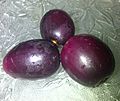Jambul facts for kids
Quick facts for kids Jamun |
|
|---|---|
 |
|
| Jambul (Syzygium cumini) | |
| Scientific classification | |
| Kingdom: | |
| Division: | |
| Class: | |
| Order: | |
| Family: | |
| Genus: | |
| Species: |
S. cumini
|
| Binomial name | |
| Syzygium cumini (L.) Skeels.
|
|
The Jamun tree (also called Jambolan, Java Plum, or Black Plum) is a tall, green tree that keeps its leaves all year. It belongs to the Myrtaceae family of flowering plants. This tree originally comes from the Indian subcontinent, parts of Southeast Asia, China, and Queensland.
People from India helped spread the Jamun tree to other tropical places. For example, the USDA brought it to Florida in 1911. Today, you can find it growing in countries like Suriname, Guyana, and Trinidad and Tobago. In Brazil, birds love to eat its fruit. They help spread the seeds, making the tree grow wild in new areas. However, in Hawaii, the Jamun tree is considered an invasive species, meaning it can take over native plants.
Contents
About the Jamun Tree
The Jamun tree grows quite fast. It can reach heights of up to 30 metres (about 100 feet). Some Jamun trees can live for more than 100 years! Its many leaves create a lot of shade, so people often plant it just for its beauty.
Strong Wood and Uses
The wood from the Jamun tree is very strong. It can also resist water well. Because of these qualities, it is used for railway sleepers (the wooden beams under train tracks). It also helps to install motors in wells. Sometimes, people use Jamun wood to make simple furniture or parts of village homes. However, it can be a bit hard to work with.
Life Cycle of the Jamun Fruit
The Jamun tree starts to grow its flowers in March or April. These flowers are small, about 5 millimetres across, and smell very nice. After the flowers, the fruit starts to appear in May and June. The fruit looks like a large berry.
Fruit Ripening and Taste
When the Jamun fruit first appears, it is green. As it gets older, it turns pink. When it is fully ripe, it becomes a shiny, dark purple or black color. The Jamun fruit has a mix of sweet and slightly tangy flavors. A fun fact about eating Jamun fruit is that it turns your tongue purple!
Different Varieties and Health Benefits
There is also a white variety of Jamun fruit. Some people believe it has special medicinal uses. The fruit is widely known for its health benefits, especially for people with diabetes. The seeds of the Jamun fruit are also used in traditional healing systems. These include Ayurveda, Unani, and Chinese medicine. They are often used to help with stomach problems.
The leaves and bark of the Jamun tree can also be helpful. They are sometimes used to help control blood pressure and treat gingivitis (gum inflammation). Besides eating the fruit fresh, people also make wine and vinegar from it. Jamun fruit is a good source of vitamin A and vitamin C, which are important for your health.
Jamun in History and Nature
The book 'The Useful Native Plants of Australia', published in 1889, mentions the Jamun plant. It states that Indigenous Australians called it "Durobbi." The book also notes that people in India ate the fruit. The Jamun fruit is a favorite food for large bats, also known as flying foxes.
Images for kids
See also
 In Spanish: Jambul para niños
In Spanish: Jambul para niños













